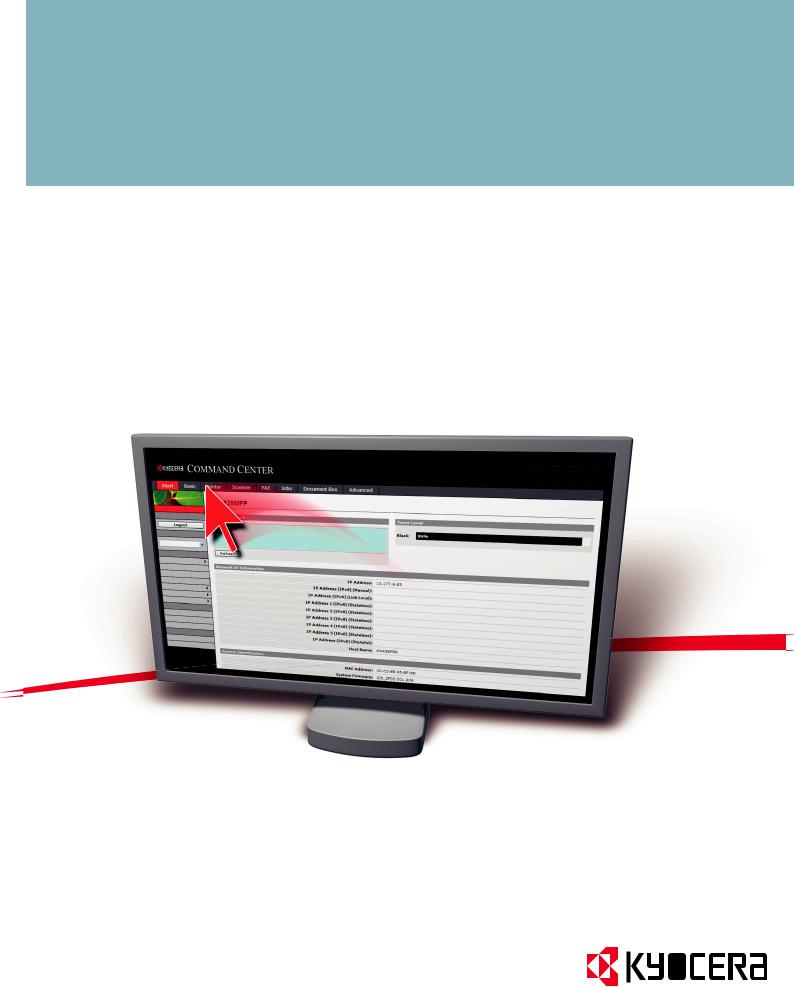Kyocera KM-C2520, KM-C3225, TASKALFA 250CI, FS-C5400DN, FS-9130DN Manual
...
OPERATION GUIDE
COMMAND CENTER
Legal and General Information
Notice
Unauthorized reproduction of all or part of this guide is prohibited. The information in this guide is subject to change without notice.
Kyocera Mita cannot be held liable for any problems arising from the use of this product, regardless of the information herein.
Regarding Trademarks
KYOCERA, KYOCERA MITA, ECOSYS and PRESCRIBE are registered trademarks of Kyocera Corporation.
KPDL and KIR (Kyocera Image Refinement) are trademarks of Kyocera Corporation.
Microsoft, Windows and Windows NT are registered trademarks of Microsoft Corporation.
Apple, AppleTalk, Mac, Macintosh, Mac OS and TrueType are registered trademarks of Apple Computer, Inc. Bonjour is a trademark of Apple Computer, Inc.
Adobe, Acrobat and Postscript are registered trademarks of Adobe Systems Incorporated.
Novell and NetWare are registered trademarks of Novell, Inc.
HP and PCL are registered trademarks of Hewlett-Packard Company. Intel, Pentium and Celeron are registered trademarks of Intel Corporation. Other brand and product names contained in this document are registered trademarks or trademarks of their respective companies.
General Information
When using this utility, the items that can be configured will differ depending on the model of your printing system or multifunctional printer (hereinafter referred to as "printing system").
Examples in this document are described in terms of the Internet Explorer 6.0 and
Microsoft Windows XP operating system environment.

Table of Contents
1 |
Introduction.............................................................................. |
1 |
|
Using COMMAND CENTER ............................................................... |
1 |
|
System Requirements ......................................................................... |
1 |
2 |
Access ...................................................................................... |
2 |
|
Accessing COMMAND CENTER ........................................................ |
2 |
|
Admin password.................................................................................. |
2 |
|
Authentication...................................................................................... |
2 |
|
Encryption ........................................................................................... |
2 |
3 |
COMMAND CENTER Pages .................................................... |
3 |
|
Start Page ........................................................................................... |
3 |
|
Basic Page .......................................................................................... |
7 |
|
Printer Page ...................................................................................... |
16 |
|
Scanner Page.................................................................................... |
18 |
|
FAX / i-FAX Page .............................................................................. |
20 |
|
Jobs Page ......................................................................................... |
31 |
|
Document Box Page ......................................................................... |
32 |
|
Advanced Page ................................................................................. |
34 |
4 |
Troubleshooting .................................................................... |
52 |


Introduction
1 Introduction
Using COMMAND CENTER
KYOCERA COMMAND CENTER (hereinafter referred to as COMMAND CENTER) refers to the web home page that is installed in the machine from which you can verify the operating status of the machine and make settings related to security, network printing, E-mail transmission and advanced networking.
System Requirements
Protocol
COMMAND CENTER operates in the following environment. Check the following before use.
•The TCP/IP protocol is installed in the PC.
•An IP address is assigned to the printing system.
Web browser
•Microsoft Internet Explorer 6.0 or later *1
•Mozilla Firefox 1.5 or later
•Safari 2.0 or later *2
*1: Microsoft Internet Explorer operates on Microsoft Windows 98SE/Me/2000/XP/ Vista, and Microsoft Windows NT 4.0.
*2: Safari operates on Apple Macintosh OS X 10.4 or later.
Operation Guide |
1 |

Access
2 Access
Accessing COMMAND CENTER
1.
2.
Run the web browser.
In Address or Location, enter the machine IP address as the URL, e.g. http://192.168.10.150/.
Select a category from the navigation bar on the left to view and set values for that category.
Admin password
Setting Administrator Password restricts general users' access to pages other than the Start page. For security purposes, setting the Administrator password is highly recommended. With some models, the default Administrator password is factory-set as admin00.
The Login button is displayed at the upper left of the screen. To access a page other than the Start page, click Login. (This button may not be displayed on some models. When this button is not displayed, click a page other than the Start page.) The password input window is displayed. Entering the predefined administrator password allows the user to access all pages.
For how to define the administrator password, refer to Basic > Security > Account Settings on page 12.
Authentication
Setting Authentication allows only the predefined users to access pages. In addition, you can discriminate users by giving either the General User or Administrator privilege to each user. Before using the authentication function, you have to define those users. For how to define users, refer to Basic > Security > User Login on page 13.
When a user sets authentication and accesses COMMAND CENTER, only the Start page is displayed. The Login button is displayed in the upper left of the screen. Click it to log in. When the user logs in with an Administrator account, hidden pages are displayed and can be accessed. When the user logs in with a General User account, the user can access the user's account page on Basic > Security > User Login and the user’s settings on the basic page and the user's document box and shared document box pages.
The authentication function come in two types: Local Authentication and Network Authentication. For more information, refer to Advanced > Management > Authentication on page 46.
Encryption
You can encrypt communication between a PC and this machine using SSL encryption. When this encryption is enabled, the access URL must be specified as "https://..." For details on the setting procedure, refer to Advanced > Security > Secure Protocols on page 48.
2 |
KYOCERA COMMAND CENTER |

COMMAND CENTER Pages
3 COMMAND CENTER Pages
The COMMAND CENTER home page divides the following functions onto separate pages. You can jump to the desired pages by clicking the tab located at the top of each page. The following is an outline of each page accessed.
Page |
Description |
|
|
Start |
This page allows you to verify this machine’s operating status and |
|
current settings. |
|
|
Basic |
This page includes settings that apply to the entire machine, such |
|
as Device Defaults, Security, and Basic Networking. |
|
|
Printer |
This page includes settings that apply to the printing function of the |
|
machine, such as Default Print Resolution and Copy Count. |
|
|
Scanner |
This page includes settings that apply to the scanning function of the |
|
machine, such as Default Scan Resolution and Original Placement. |
|
|
FAX / i-FAX |
This page includes settings that apply to the FAX function of the |
|
machine, such as FAX transmit and receive settings. |
|
|
Jobs |
This page includes information on all device jobs including job |
|
status, scheduled job and job log. |
|
|
Document |
This page allows you to add and delete a document box, and |
Box |
delete documents within a document box. |
|
|
Advanced |
This page includes advanced settings that apply to the entire |
|
machine and is comprised primarily of advanced network settings. |
|
|
Start Page
The following operations are possible from the Start page.
•Verifying the machine’s operating status
•Logging in or out during setting of the administrator password
•Changing the language that COMMAND CENTER is displayed in
•Verifying various settings (machine, printing, FAX, scanning, network and E-mail)
•Verifying the number of scanned pages and the number of prints made on the machine
•Access linked home pages
All users will have access to the Start page.
Operation Guide |
3 |

COMMAND CENTER Pages
Start > Start
This page allows you to verify the machine’s operating status. This will be the first screen that appears after COMMAND CENTER has been started up.
Item |
Description |
|
|
|
|
Select |
Appears if COMMAND CENTER pages support multiple |
|
Language |
languages. |
|
|
To change COMMAND CENTER language: |
|
|
1. Open the Select Language drop down list by clicking it. |
|
|
2. Select the appropriate language. |
|
|
If you attempt to view COMMAND CENTER with a character |
|
|
set other than the language that is used on the operation |
|
|
panel’s display, some characters may be illegible. |
|
|
|
|
Operation Panel |
This indicates the machine’s operating status as displayed |
|
|
on the operation panel. To update the display to the most |
|
|
recent status, click the Refresh button. |
|
|
|
|
Toner Level |
This shows the approximate level of remaining toner. The closer |
|
|
the value to 0%, the smaller the amount of remaining toner. If |
|
|
you use non-original toner kit, the toner gauge measurement |
|
|
will not be indicated correctly. |
|
|
|
|
Network IP |
Network IP information on the printing system is displayed. |
|
Information |
This allows you to verify the following information: |
|
|
- |
IP Address |
|
- |
IPv6 Address (Manual) |
|
- |
IPv6 Address (LinkLocal) |
|
- IPv6 Addresses 1 to 5 (Stateless) |
|
|
- |
IPv6 Address (Stateful) |
|
- |
Host Name |
|
|
|
System |
System information on the printing system is displayed. This |
|
Identification |
allows you to verify the following information: |
|
|
- |
MAC Address |
|
- |
System Firmware |
|
- |
Engine Firmware |
|
- |
Panel Firmware |
|
- |
FAX Firmware |
|
- |
Serial Number |
|
- |
Asset Number. |
|
|
|
Media Input |
This shows paper size and media type for cassettes and MP tray. |
|
|
|
|
Start > Status Pages
These pages allow you to verify the various settings (machine, printing, scanning, network and E-mail) that were made on the operation panel or using COMMAND CENTER.
It is divided by the following items.
-Network
-Device/Printer
-Scanner
-Device/Printer
-FAX / i-FAX
-Jobs
-Counters
4 |
KYOCERA COMMAND CENTER |

|
|
COMMAND CENTER Pages |
|
|
|
|
|
|
|
|
|
|
Item |
Description |
|
|
|
|
|
|
Network > |
This allows you to verify the current settings for LDAP, TCP/ |
|
|
General |
IP, IPP, IPP over SSL, AppleTalk, NetBEUI, IPv4, and IPv6. |
|
|
|
For more information, refer to Advanced Page on page 34. |
|
Network > IP
Filters
This displays the list of IP addresses and subnet masks (IPv4) or prefix length (IPv6) that have access permission as set under IP Filters (IPv4) and IP Filters (IPv6) on the
Advanced page. If no IP addresses have been designated, then access permission will be granted to all addresses. For more information, refer to Advanced > Protocols > TCP/ IP > IP Filters on page 36.
Network >
SNMP
This allows you to verify the settings made under SNMPv1/ v2 and SNMPv3 on the Advanced page.
For more information on SNMPv1/v2, refer to Advanced > Management > SNMP > SNMPv1/v2c on page 43.
For more information on SNMPv3, refer to Advanced > Management > SNMP > SNMPv3 on page 44
Network >
POP3/SMTP
This allows you to verify the E-mail-related settings made on POP3 and SMTP pages of the Advanced page.
For more information on POP3, refer to Advanced > E-mail > POP3 > General on page 42.
For more information on SMTP, refer to Advanced > E-mail > SMTP > General on page 40.
Network >
Logical Printers
This allows you to verify the settings made on the Logical Printers page of the Advanced page.
For more information, refer to Advanced > Protocols > TCP/ IP > Logical Printers on page 37.
Network >
Netware
This allows you to verify the settings made on the Netware page of the Advanced page.
For more information, refer to Advanced > Protocols > Netware on page 38.
Security |
This allows you to verify the current settings for secure |
|
protocols, IEEE802.1x, and IPSec. To change the settings: |
|
For secure protocols, refer to Advanced > Security > Secure |
|
Protocols on page 48; For IEEE802.1x, refer to Advanced > |
|
Security > IEEE802.1x on page 49; For IPSec, refer to |
|
Advanced > Security > IPSec > Rule1 (to Rule3) on page 50. |
|
|
Device/Printer |
This allows you to verify the settings made on the Basic and |
|
the Printer pages. |
|
For more information, refer to Basic Page on page 7 and |
|
Printer Page on page 16. |
|
|
Device/Printer > |
This allows you to verify the settings made on the Basic and |
APL. Filter |
the Printer pages. |
|
For more information, refer to Printer Page on page 16. |
|
|
Device/Printer > |
This allows you to verify the settings made on the Basic and |
APL. Filter |
the Printer pages. |
Parameters |
For more information, refer to Printer Page on page 16. |
|
|
Scanner |
This allows you to verify the settings made on the Scanner |
|
page. |
|
For more information, refer to Scanner Page on page 18. |
|
|
Operation Guide |
5 |

COMMAND CENTER Pages
Item |
Description |
|
|
|
|
FAX / i-FAX > |
This allows you to verify the settings made on the FAX / i-FAX |
|
General |
page. |
|
|
For more information, refer to FAX / i-FAX Page on page 20. |
|
FAX / i-FAX > |
||
|
||
FAX |
|
|
|
|
|
FAX / i-FAX > i- |
|
|
FAX |
|
|
|
|
|
Jobs > Printing |
This allows you to confirm the log of the jobs in each operation. |
|
Jobs Log |
For more information, refer to Jobs Page on page 31. |
|
|
|
|
Jobs > Sending |
|
|
Jobs Log |
|
|
|
|
|
Jobs > Storing |
|
|
Jobs Log |
|
|
|
|
|
Counters > |
This allows you to verify the accumulated number of printed |
|
Printed Pages |
pages for each paper size and color (Monochrome, Mono |
|
|
Color, and Full Color). A page printed on both sides, an A3- |
|
|
sized sheet of paper, or a page larger than Ledger size is |
|
|
counted as two pages. |
|
|
|
|
Counters > |
Provide information of the number of pages copied, faxed, |
|
Scanned Pages |
and scanned, respectively. |
|
|
|
Start > Information
This page provides information about the Address Book, User Login, the model number of the machine and version of firmware.
Item |
Description |
|
|
Address Book |
This page provides information about the maximum and |
|
current numbers of addresses possible to add to the private |
|
and group Address Books. For more information, refer to |
|
Basic > Defaults > Address Book > Groups on page 11 and |
|
Basic > Defaults > Address Book > Groups on page 11. |
|
|
User Login |
This shows the number of registered users. For more |
|
information, refer to Basic > Security > User Login on page 13. |
|
|
About |
The model number of this printing system and Version of |
|
Firmware can be confirmed. |
|
|
Start > Links
Links to the Kyocera Mita Corporation web site. Visit the following web site for more information and downloads.
Item |
Description |
|
|
Download |
http://www.kyoceramita.com/download/ |
Drivers |
|
|
|
6 |
KYOCERA COMMAND CENTER |

COMMAND CENTER Pages
Item |
Description |
|
|
Kyocera Online |
http://www.kyoceramita.com/ |
|
|
Basic Page
This section includes settings that apply to the machine, such as Device Defaults, Security, and basic Networking. If the Admin password has been set, pages in this section are available only to the Administrator.
Basic > Defaults > Network
This page allows you to make the settings that are required for network printing and sending E-mail. For more information, refer to Advanced > Protocols > TCP/IP > General on page 35.
You must restart this machine after you have completed these settings in order to properly register the content of those settings in the machine. Refer to Basic > Defaults > Reset on page 9.
Item |
Description |
|
|
Host Name |
Specifies a name for the printing system network |
|
component. This name is used as the NetBEUI printer name |
|
and as the WSD device name. |
|
|
LAN Interface |
Specifies the communication rate from Auto, 10BASE-T-Half, |
|
10BASE-T-Full, 100BASE-TX-Half, and 100BASE-TX-Full. |
|
After you have changed this setting, you must restart this |
|
machine. For the restarting procedure, refer to Basic > |
|
Defaults > Reset on page 9. |
|
|
IPv4 Settings |
Specifies whether or not to obtain an IP address using |
DHCP/ |
|
BOOTP |
DHCP or BOOTP. |
|
|
IP Address |
Assigns the Internet Protocol address on the printing system |
(IPv4) |
network component. Format of the IP address is four-byte |
|
(32-bit) numbers separated by dots, e.g. 192.168.110.171. |
|
|
Subnet |
Specifies the subnet mask of the hosts or network with which |
Mask |
the print system is connecting. If you have manually |
|
assigned an IP address that starts with a number between |
|
192 and 223, it is recommended that you set the subnet |
|
mask to "255.255.255.0." |
|
|
Default |
Specifies the IP address of the default gateway. |
Gateway |
|
|
|
IPv6 Settings |
Specifies whether or not to enable the IPv6 protocol. |
IPv6 |
|
|
Select On to use the IPv6 protocol. |
|
|
IP |
Assigns an IPv6 address to the printing system network |
Address |
component. The format of the IPv6 address is a sequence of |
(IPv6) |
numbers (128 bit in total) separated by colons, e.g. |
|
2001:db8:3c4d:15::1a2c:1a1f. |
|
|
Operation Guide |
7 |

COMMAND CENTER Pages
Item |
Description |
|
|
Prefix |
Specifies the IPv6 prefix length of the hosts or network with |
Length |
which the print system is connecting. |
|
|
RA |
Select On to use RA to configure IPv6 addresses. |
(Stateless) |
|
|
|
Default |
Specifies the IPv6 address of the default gateway. |
Gateway |
|
|
|
DHCPv6 |
Specifies whether or not to obtain IPv6 IP addresses by |
|
automatic configuration. When RA is turned On, the IP |
|
addresses and server information are obtained via DHCPv6 |
|
based on the settings of the automatic configuration made |
|
under RA (router setting). |
|
|
Basic > Defaults > Time
If a time server is used to synchronize the time as well, the current time can be adjusted regularly and easily. Enter the IP address of the time server and click the Synchronize button.
Time information is required when you receive reports from this machine via E-mail. It is recommended that you set the time when the report mail function is enabled.
Item |
Description |
|
|
Current Local |
Displays the time that is currently set in the machine. |
Time |
|
|
|
Current |
Displays the Greenwich Mean Time that is currently set in |
Universal Time |
the machine. |
(UTC/GMT) |
|
|
|
Time Zone |
Sets a time difference. Click the drop down list and select |
|
your region. |
|
|
Summer Time |
Switches the Summer Time setting On and Off. Select On in |
|
order to have the Summer Time function applied when the |
|
time is synchronized with a time server. |
|
|
Time Server |
Enter the host name or IP address of the time server from |
|
which you want to acquire the time. |
|
|
Synchronize |
Click the Synchronize button to synchronize the registered |
with Time |
time with the designated timer server. |
Server now |
|
|
|
Synchronization |
Displays the results of the synchronization operation with the |
Status |
time server. |
|
|
8 |
KYOCERA COMMAND CENTER |

COMMAND CENTER Pages
Basic > Defaults > Reset
This page allows you to restart the machine in order to make all settings in the machine valid. It is also possible to select to have all settings returned to their factory default values.
Item |
Description |
|
|
Restart entire |
Clicking Restart restarts this machine restarts. |
device |
|
|
|
Restart Network |
Clicking Restart allows restarting the network interface |
|
without restarting the machine. |
|
The network interface must be restarted whenever a change |
|
has been made to the network settings. |
Reset entire device to factory default
When clicking the Reset button, the machine returns to the factory default settings. However, the document box, address book, user information, logs, and certificates are not deleted.
Basic > Defaults > Device Defaults
This page allows you to change the language that is used in the display, as well as to turn the Auto Sleep Mode On or Off.
Item |
Description |
|
|
Operation Panel |
You can select the language of the messages on the display |
Language |
by following the procedure given below. The following |
|
languages are available for selection in the drop down list: |
|
English, Français, Deutsch, Italiano, Nederlands, Español, |
|
Português, Russian, and the downloaded languages |
|
You can optionally download messages in other languages. |
|
Contact your dealer for information. |
|
Some models may require restarting after configuration. |
|
|
Sleep Timer |
Specifies the time from 1 to 240 minutes after which the |
|
system enters the auto sleep mode. |
|
You can turn the sleep timer On or Off as follows. The |
|
default setting is On. |
|
1. Click Advanced on the right hand side of the drop down |
|
list. |
|
2. Turn the sleep mode On or Off. |
|
3. Click Submit. |
|
|
Low Power |
Specifies the time from 1 to 240 minutes after which the |
Timer |
system enters the low power mode, where it reduces the |
|
power consumption. |
|
|
Override A4/ |
Specifies whether or not the A4 and Letter size paper should |
Letter |
be interchangeable.When turned On, for example, if the A4 |
|
paper is not in the tray, the Letter size paper will be selected |
|
for printing.When turned Off, the Letter size paper will not be |
|
used in place of the A4 paper, when A4 is selected for |
|
printing but the A4 tray is empty. |
|
|
Auto Error Clear |
Specifies whether or not to clear errors automatically when |
|
they occur. |
|
|
Operation Guide |
9 |

COMMAND CENTER Pages
Item |
Description |
|
|
Error Clear Timer |
Specifies the time between 5 and 495 seconds after which |
|
errors are cleared automatically. |
|
|
RAM Disk Mode |
Specifies whether to use a part of the print system memory |
|
as a RAM disk. You can specify the size of the print system |
|
memory to use for the RAM disk. If this item is On, electronic |
|
sorting is enabled and the printing speed increases. After |
|
you have changed the setting, you must restart the printing |
|
system. |
|
|
RAM Disk Size |
Specifies the size of the RAM disk. For allowable sizes, refer |
|
to the print system operation guide. After you have changed |
|
the setting, you must restart the printing system. |
Interrupt Clear
Time
This determines the time of period before the machine reverts to normal mode, after the interrupt copy mode has been engaged. The range is 5 to 459 seconds (in 5-second increments).
WSD Scan Timer |
This determines the time of period before the machine |
|
reverts to normal mode, after WSD scan mode has been |
|
engaged. The range is 10 to 495 seconds (in 5-second |
|
increments). |
|
|
File Name |
You can change the file name for the scan data or the job |
|
name for the jobs on the Job page. |
|
|
Additional |
You can add a Job Number or the Data and Time to the File |
Information |
Name designated above. The additional information varies |
|
depending on model. |
|
|
Unusable Time |
This restricts use of the machine by time of day. When |
Setting |
turned On, the machine becomes unoperative during the |
|
time of day specified by Unusable Time. Except, the |
|
received FAXes are stored in the machine and printed after |
|
the unusable time period has been expired. |
|
|
Unusable Time |
This determines the time of period during which the machine |
|
is restricted for use. This is enabled when Unusable Time |
|
Setting is On. |
|
|
Basic > Defaults > Address Book > Contacts
1.
2.
3.
4.
1.
This page allows you to add, edit or delete Contacts.
Adding a New Contact
Open the Address Book Contacts page.
Click Add Contact. The Address Book Contacts - Add page opens.
Enter the information for the address to be registered. You can specify a FAX number and i-FAX address even if the FAX System is not installed.
Click Submit.
Editing a Contact
Open the Address Book Contacts page.
10 |
KYOCERA COMMAND CENTER |

COMMAND CENTER Pages
2. Click the number or name of the address to edit. The Address Book Contacts - Edit page appears.
3.
4.
Modify the information of the address.
Click Submit.
Deleting a Contact
1.
2.
Open the Address Book Contacts page.
Check the desired contact. When the check box on the left side of Number is selected, all contacts displayed on the page will be checked.
3. Click Delete Contact.
The Address Book Contacts - Delete page appears. You can confirm the addresses to be deleted
4. Click Delete when the desired addresses are selected.
Basic > Defaults > Address Book > Groups
1.
2.
3.
4.
This page allows you to add, edit or delete Groups.
Adding a New Group
Open the Address Book Groups page.
Click Add Group.
The Address Book Groups - Add page opens.
Enter the number and name of the group.
Click Submit.
The Address Book Groups - Add Members page opens.
5. Select the members to be added to the created group.
Check the members you want to add. The members must be registered before added.
6. After you have selected the members, click Submit.
The Address Book Groups - Edit page opens. You can continue editing groups, such as changing group names and adding or deleting members.
1.
2.
Editing a Group
Open the Address Book Groups page.
Click the number or name of the group to edit. The Address Book Groups - Edit page opens.
3. You can change the number or name of the group and add or delete members.
To add members, click Add Members and select the addresses to add. The members must be registered before added.
4. After you have finished editing, click Submit.
Deleting a Group
1. Open the Address Book Groups page.
Operation Guide |
11 |

COMMAND CENTER Pages
2. Check the desired group. When the check box on the left side of Number is selected, all groups displayed on the page will be checked.
3. Click Delete Group.
The Address Book Groups - Delete page appears. You can confirm the group to be deleted.
4. Click Delete when the desired group is selected.
Basic > Security > Account Settings
1.
2.
3.
4.
The Administrator (Admin) account is the master access account. It controls access to the printer and networking configuration from all setup and management utilities including the HTML web pages.The Admin password set in the following is valid when
Authentication is set to Off. For details on Authentication, see Advanced > Management > Authentication on page 46.
Setting the Admin password is highly recommended to prevent unauthorized changes to the machine and networking configuration. With some models, the default Administrator password is factory-set as admin00. It is recommended to periodically change password.
To change the password:
Enter the Old Password.
Enter the password you want to set in New Password. This can be up to 32 (30 with some models) character long.
Enter the same password in Confirm New Password.
Click the Submit button.
Basic > Security > Device Security > General
This page allows you to restrict access from the operation panel or USB host device. In addition, an explanation about each security setting is displayed.
Item |
Description |
|
|
Lock Operation |
Restricts access from the operation panel. |
Panel |
When it is set to Block, use of the System menu on this |
|
machine, registration in and editing of the Address Book and |
|
Box, use of the Stop key, and cancellation of jobs are forbidden. |
|
When it is set to Partial Lock, use of the System menu on |
|
this machine and registration in and editing of the Address |
|
Book and Box are forbidden. |
|
When it is set to Unlock, use of all keys is permitted. |
|
|
Filtering/ |
An explanation about each security setting is displayed. |
Firewall, |
When you click a link in the sentence, the appropriate tab of |
SNMPv1/v2, |
the Advanced page opens. |
SNMPv3, SSL, |
|
IPSec, |
|
IEEE802.1x |
|
|
|
12 |
KYOCERA COMMAND CENTER |

COMMAND CENTER Pages
Basic > Security > Device Security > Interface Block
This page allows you to restrict access from each interface.
Item |
Description |
|
|
Network |
Specifies whether or not to restrict access from each of the |
|
interfaces on the left. Access from the interfaces that are set |
|
|
USB Device |
to Block is restricted. |
|
Access from the network interface cannot be restricted. |
USB Host |
|
|
Access can be restricted on a per-protocol basis. Refer to the |
|
|
Parallel I/F |
next section. |
|
|
Optional I/F |
|
|
|
Basic > Security > Device Security > Network Security
This allows you to enable communication with the printing system on a per-protocol basis.
Item |
Description |
|
|
SNMP v3, |
Specifies whether or not to restrict communication via each |
NetWare, |
of the protocols on the left. |
AppleTalk, |
The communication via the protocols that are set to Lock is |
NetBEUI, Raw, |
restricted. |
IPP, IPP over |
The settings made on this page affect the protocol settings |
SSL, HTTP, |
|
HTTPS, FTP |
on the Advanced page. |
(Transmission), |
|
FTP |
|
(Reception), |
|
SMB, SNMP, |
|
SMTP, POP3, |
|
LPD, LDAP, |
|
WSD Print, |
|
WSD Scan |
|
|
|
Basic > Security > User Login
1.
2.
3.
When the authentication function is set on the Advanced > Management > Authentication page (Local Authentication, depending on model), you must register users and set access levels on this page.The available access levels are User and
Administrator.
One administrator account is registered by default.
Adding a New User Login
Open the User Login page.
Click Add and enter the information of the user.
Click Submit.
Operation Guide |
13 |

COMMAND CENTER Pages
1.
2.
Editing a User Login
Open the User Login page.
Click the desired Login User Name or Name to edit the user and modify their information.
3.
1.
2.
Click Submit.
Deleting a User Login
Open the User Login page.
Check the desired user. When the check box on the left side of Login User Name is selected, all users displayed on the page will be checked.
3. Click Delete.
The User Login - Delete page appears. You can confirm the users to be deleted.
4. Click Delete when the desired users are selected.
Basic > Security > Certificates
This page allows you to create or update certificates or check details on certificates. After you have changed this setting, you must restart this machine. For the restarting procedure, refer to Basic > Defaults > Reset on page 9
Device Certificate - Self Issued
The self-issued certificate is automatically issued by default. The automatically issued certificate has the country code, common name (in a form of "KMxxxxxx" as for model names), and a validity period of about 10 years already configured.
Item |
Description |
|
|
Self Certificate |
Displays whether the certificate is valid. |
|
|
Expiration |
Displays the validity period of the certificate. |
|
|
View Certificate |
Click View to view details on the certificate. |
|
|
Create |
Click Create to create a certificate. |
Certificate |
|
|
|
Edit Certificate |
Click Edit to update the validity period of the certificate. |
|
|
Export |
Click Export to display the download dialog for the file. Click |
Certificate |
Save to download the exported certificate. |
|
If the printing system supports self-issued certificates only, it |
|
cannot carry out encrypted communication via IPP over SSL |
|
with Windows Vista because the IPP over SSL function of |
|
Windows Vista does not deem self-issued certificates as |
|
trusted. To enable printing via IPP over SSL, export the self- |
|
issued certificate from the printing system and import it into |
|
Windows Vista as a trusted certificate. In this case, the |
|
access name must match the common name of the |
|
certificate. |
|
|
14 |
KYOCERA COMMAND CENTER |
